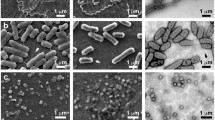Abstract
THE technique of shadowing specimens with metal vapour in high vacuum is now a frequent practice in electron microscopy1. The same technique may also be used with advantage in photomicrography, in order to bring out details of surface structure which are otherwise invisible. The present work is a study of the flagellate form of Leishmania donovani, the parasite of kala-azar, both with electron and shadowed photomicrographs.
Similar content being viewed by others
References
Williams, R. C., and Wyckoff, R. W. G., J. App. Phys., 15, 712 (1944).
Robinow, C. F., J. Hyg., 43, 413 (1944).
Author information
Authors and Affiliations
Rights and permissions
About this article
Cite this article
DAS GUPTA, N., BHATTACHARYA, D. & SEN GUPTA, P. Electron and Photomicrographic Studies of the Flagellate Form of Leishmania donovani. Nature 167, 1063–1064 (1951). https://doi.org/10.1038/1671063b0
Issue Date:
DOI: https://doi.org/10.1038/1671063b0
- Springer Nature Limited





